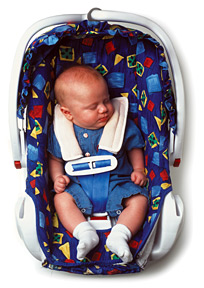Car Seats Don't Ensure Complete Protection
You would think that with all of these new safety measures and car seat laws in every state, children would be completely safe during an auto accident. Not so. Despite all the latest enhancements to car seat safety, injuries caused by motor-vehicle collisions remain the leading cause of death in children ages 3 to 14. They are also the leading cause of disabling injuries in that age group.
Just as a seat belt is meant to restrain an adult during an auto accident, the car seat has the same purpose; they are called child
restraint systems, not child life preservers, for that very reason. Many parents mistakenly believe that if their child is in a car seat, they are immune from injury during a motor-vehicle collision; in reality, the purpose of the car seat is only to lessen the degree of risk to the child - it cannot completely remove the risk.
It's easier to comprehend if you compare child car seats/restraints to their adult counterparts: seat belts and air bags. Few adults would consider themselves completely safe just because they're buckled up and have an air bag-enabled vehicle, so why would children be any safer?
 Child Injuries: Some You See, Some You Don't
Child Injuries: Some You See, Some You Don't
Most insurance companies and many parents mistakenly believe that a child in a car seat is somehow invulnerable to injuries. Why is this? Generally, if a child doesn't complain of pain, it never occurs to a pediatrician or parent that any injury was sustained during the collision. Due to their inability to communicate their pain or discomfort, symptoms such as irritability, lethargy, restlessness, night terrors, poor focus and/or appetite, change in bowel movements and being very clingy may be the only signs that an infant or child has suffered an injury.
It's important to realize that even a child in a safety seat can be injured. They're may not be thrown around the car or into the back of the seat in front of them, but they can still suffer from the impact. Their body is held to the car by the restraint, but their head and arms can easily be thrown forward, which may cause mild to severe damage to their spine and nervous system.
The SUV and Your Child
The sports utility vehicle (SUV) is still considered popular these days, partially due to their large size and versatility. Parents also may invest in an SUV because they believe the vehicle's size protects their children (and them) from injury in a crash. Not necessarily so, according to a recent study published in the research journal Pediatrics.
Researchers considered a sample of 3,922 child occupants, ages 0-15, who suffered severe injuries in auto accidents, comparing the injuries sustained by children riding in passenger cars with those riding in SUVs. Severe injuries included but were not limited to concussions and other brain injuries; spinal cord injuries; facial fractures and lacerations; internal organ injuries; extremity fractures; and scalp lacerations. (As you might imagine, many of these injuries could not be avoided simply by being restrained in a car seat.)

